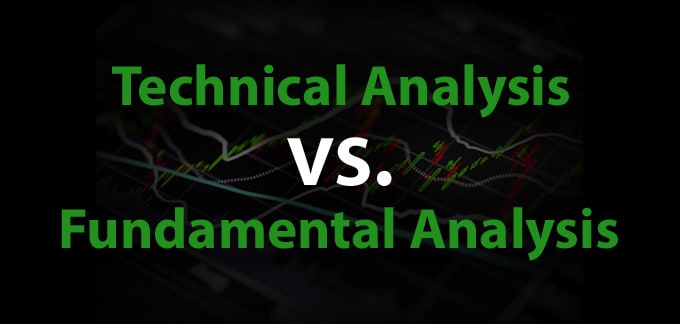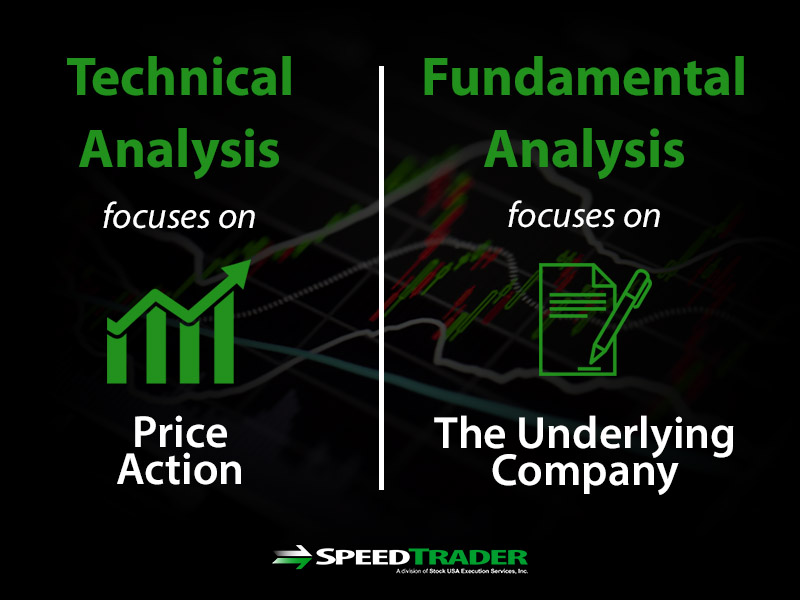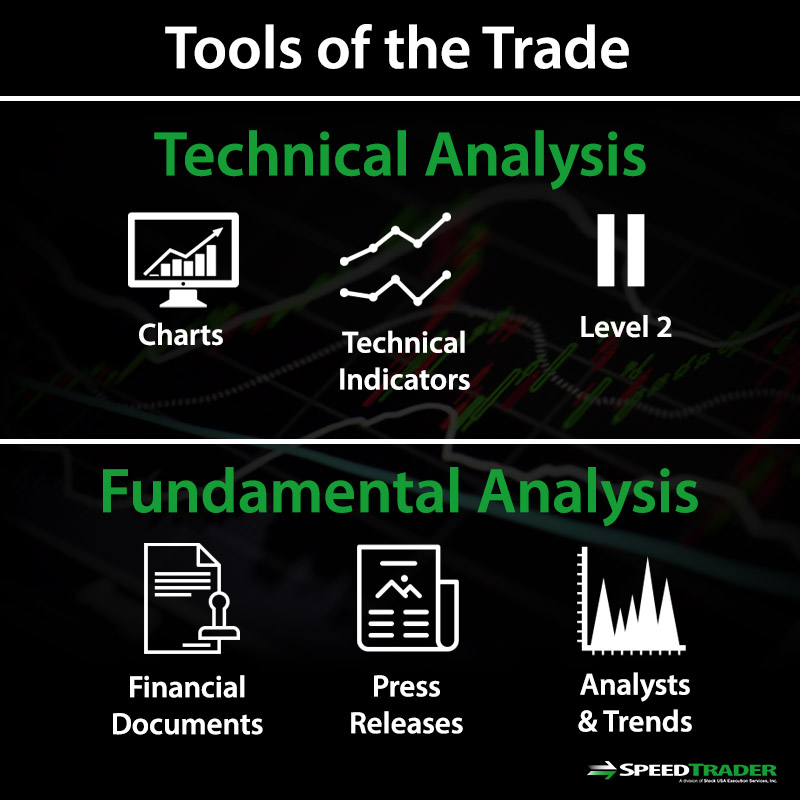In the world of trading and investing, there are two types of analysis performed to research stocks: technical analysis and fundamental analysis.
Technical Analysis vs. Fundamental Analysis
Technical analysis focuses solely on the price action of a stock. It provides a visual trajectory of the stock’s price movement by utilizing charts and indicators. Technical analysis utilizes chart-based tools to identify historical price patterns to help forecast the direction of the stock, while identifying areas of price support and resistance.
Fundamental analysis focuses on the financial and qualitative metrics of the underlying business. It analyzes the financial performance of the underlying business to derive an accurate valuation of the company moving forward. Data is derived from news, press releases and financial filings with regulatory agencies. There often lies a disconnect between a stock’s price movement and the performance of the underlying business, which are two completely separate interpretations.
For example, stock XYZ is trading down -2% after releasing anticipated news of securing a lucrative $1 billion federal contract. While the news is bullish for the business, the stock price may be trading down due to a bearish technical price pattern. This disconnect where positive news results in negative stock price movement can be interpreted efficiently through technical and fundamental analysis.
Up to 70% of a stock’s daily price movement can be attributed to the general market movement on any given day, depending on its inclusion into benchmark indices and exchange-traded funds (ETFs). This means that while news from Microsoft may be released daily, the general movement of the S&P 500 will still account for up to 70% of the directional price moves on a daily basis. This often explains why seemingly good news results in little to negative price action.
Ideally, both forms of analysis should be implemented to attain a more in-depth perspective of the company and it’s stock pricing.
Which is Better: Technical or Fundamental?
The question of which is better relies on the purpose of the analysis. Day and swing trading focuses mostly on short-term intra and multi day price action and rely heavily on technical analysis to profit from price patterns. Long-term investing relies more on fundamental analysis. While both forms of analysis should be utilized, a heavier emphasis on one or the other is required in most cases.
Tools of the Trade
Different tools are used when performing technical and fundamental analysis.
Technical Analysis Tools
Charts are like the canvas that displays the story of the price action. The most popular charts among traders are candlestick and bar charts. Both types of charts display the price history of the underlying stock based on user selected time frames that can range from 1-minute to monthly.
Indicators are derived from price and volume data and can be used to gain further insights into key price levels. Selecting the right indicators help to identify support and resistance price levels, trends and potential future price targets. Moving averages are commonly used to quantify areas of support and resistance. These are dynamic indicators that update their values throughout the day. Momentum indicators like MACD, Stochastic and RSI measure the overbought and oversold status of the current and historic price movement. Combining various indicators can help to generate a cumulative effect that provides trading signals when they converge.
Level 2 is an additional data feed provided by the stock exchanges to provide additional market depth information in regards to bid and ask pricing. Day traders commonly utilize level 2 to quickly gauge the potential liquidity of supply and demand at any given time. This helps to pinpoint entries and exits when trading signals trigger.
Fundamental Analysis Tools
Financial Documents are the key source of material information about the business directly from the company. Publicly traded companies are required to submit financial documents to the United States Securities and Exchange Commission (SEC).
SEC Filings are required on a quarterly basis and annual basis. The 10-Q is a quarterly financial report that details the financial performance of the company for the prior quarter. The 10-Q reports the company’s revenues, expenses, profit/loss on the income statement as well as a detailed balance sheet and statement of cash flow. This report helps analysts and investors derive a future valuation for the stock. Companies are required to file an 8-K report when there is an event that could make a material impact on the financial performance of the company including change in directors, lawsuits, regulatory violations and acquisitions. The 10-K is the annual report that summarizes the company’s annual performance, which may include the fourth-quarter financials.
Press releases and news can have a material impact on stock prices. Companies may release news through various sources like Dow Jones, Reuters, Bloomberg and PR Newswire. News is often a catalyst for price action; however, technical analysis should be used when measuring the impact of said news. Large companies tend to release news daily, but not every press release will impact the stock price. Prudent investors and traders will discern between material news and fluff.
Industry trends can have a material impact on stocks within the industry/sector. For example, if the energy industry appears to have a positive future outlook, certain stocks within that industry may be more prone to bullish moves.
Investors can research these trends through news feeds and various articles. Most industries also have exchange-traded-funds (ETF) that can be tracked. The leading companies within specific industries represent the trends, which trickle down to the lower tier companies.
Analyst reports are usually released to brokerage customers, but still make their way onto news wires. Most reports and ratings may have a short-term impact on stock price. The broker usually provides access to analyst reports. It is important to be aware that these reports may be biased, if the broker has investment banking relations with the underlying company.
Accounting ratios are popular, quick and effective measures of a company’s financial performance. They allow for comparative analysis within sectors against the peers and general markets. Some of the most widely used ratios are price-earnings (P/E), price-sales (P/S), book value, cash-per-share, free cash flow, earnings-per-share (EPS), and year-over-year (YOY) growth. These metrics can be used to compare companies within a sector to see how they compare with each other. Often times, investors will be able to spot companies that may be undervalued compared to their peers by implementing these ratios.
Shorter Versus Longer Time Frames
A shorter time frame is generally considered as a holding period intra-day or overnight. Mostly day traders, who prefer to close positions before the end of the trading session to avoid overnight risk, utilize this time frame. The intra-day time frames can range from minutes to hours. Emphasis is tilted more towards technical analysis, as time frames get smaller.
Longer time frames refer to holding periods that may range from several days to years. Swing traders will often engage in the shorter version of this by holding positions from one day to several weeks. Investors will usually hold positions for months to years. Emphasis gets tilted more towards fundamental analysis, as time frames get longer.
Combining Technical and Fundamental Analysis
Can the two analysis styles be combined? Yes. A seasoned trader will always incorporate both forms of analysis into every trade. Depending on the time horizon of the trade, the trader may place more emphasis on technical or fundamental analysis as the top premise.
Both forms of analysis are needed to ensure prudent trade management in all forms of trading. Technical analysis is needed to accurately determine the price trajectory and to execute proper entries and exits. After all, a stock is traded on a public exchange and the motive behind trading or investing is to profit from price appreciation. Anything that has to do with a stock’s pricing must be analyzed with technical analysis. A technical trader may incorporate fundamental analysis by analyzing the validity and significance of a certain fundamental catalyst (such as a press release or earnings report).
Fundamental analysis is used to determine the value of the underlying business in the present and future. Additionally, fundamental analysis is used to ascertain the sentiment for the stock, peers, sector and the markets in general. Sentiment, just like perception is reality, in the markets. Fundamentals help to explain why a stock’s price made a specific move, but usually that is after the fact. A fundamental trader incorporate technical analysis to identify ideal entry/exit points after he/she has formulated a hypothesis about the future outlook of the underlying company.
The Galvanized Trader
In this age of algorithmic trading programs, a trader needs to be fluent in both forms of analysis to compete effectively. The days of past where traders could trade solely on new releases is long gone. High frequency trading and algorithmic trading programs have the advantage of speed and limitless capital. They can react to news releases in milliseconds taking away any speed advantage for a news-based trader, who often ends up chasing the liquidity. For this reason, traders need to be able to not only have effective charting but also an understanding of how the crowd will react to the news. A seasoned trader focuses on the seamless shifting between technical and fundamental analysis as the trade dictates. Integrating both skill sets helps to galvanize the trader’s defense and offense, allowing him to sidestep and coattail the algorithms or avoid completely intra-day by shifting to longer time frames.



